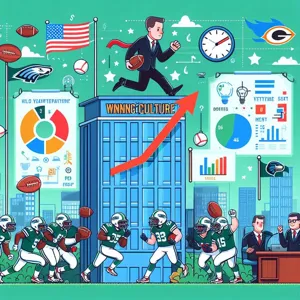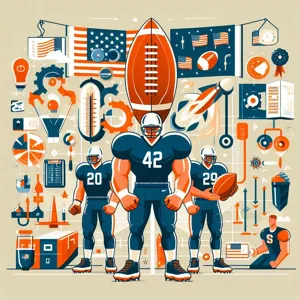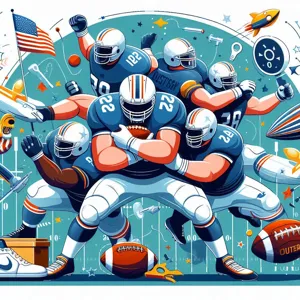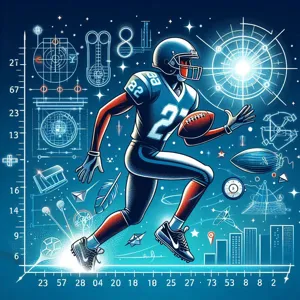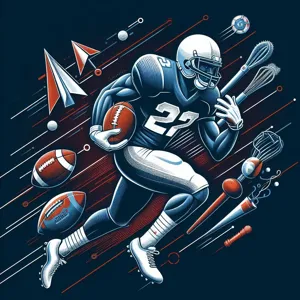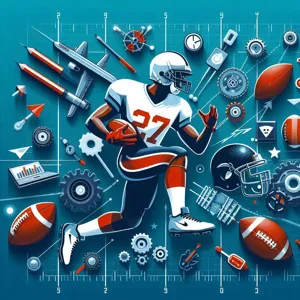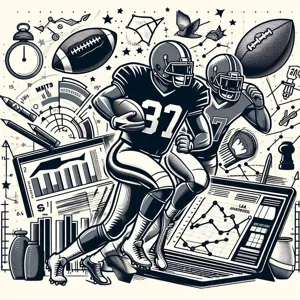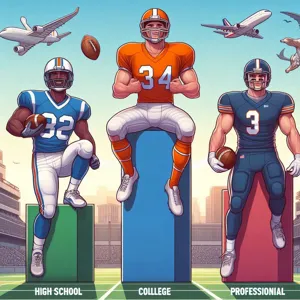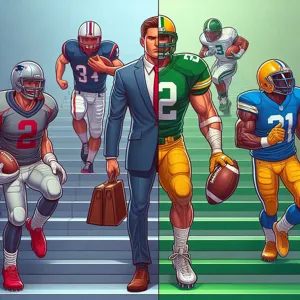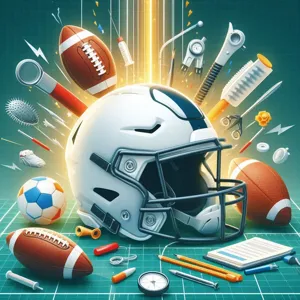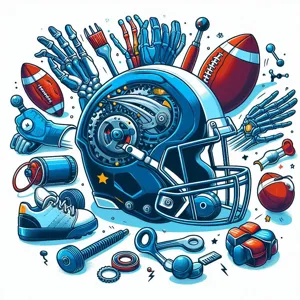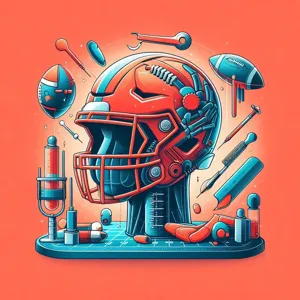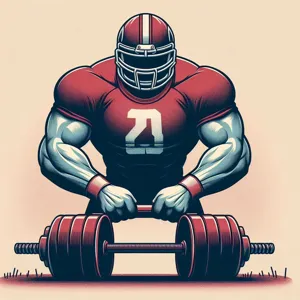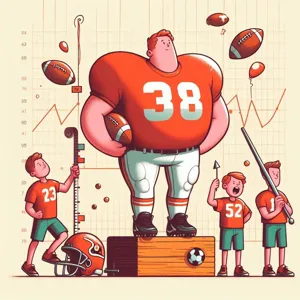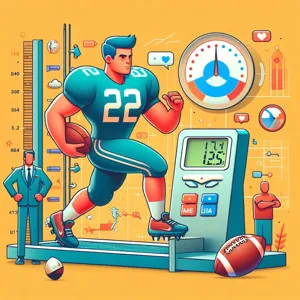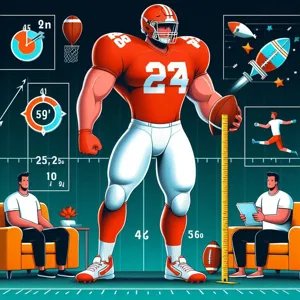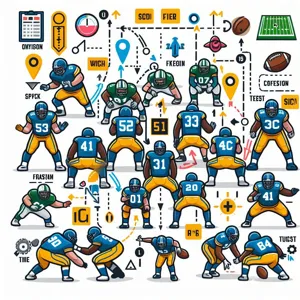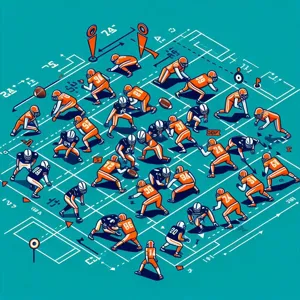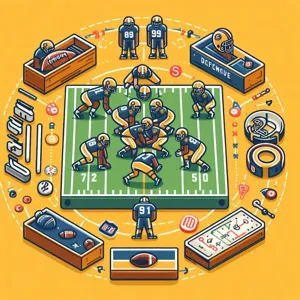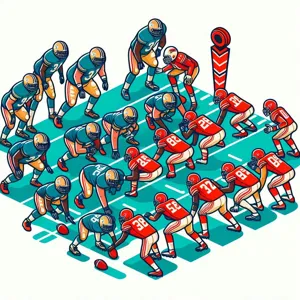In the high-octane realm of American football, physical prowess is only part of the equation for success; mental resilience is the true game-changer.
As athletes face the rigors of intense competition, grueling training sessions, and the pressure of high-stakes games, cultivating mental toughness becomes essential. This ultimate guide, “Unlocking Resilience,” dives deep into the strategies and techniques that can help players develop the unwavering mindset necessary to thrive on and off the field. From visualization and goal-setting to mindfulness practices and adaptive coping mechanisms, we’ll explore a comprehensive array of tools that can bolster mental fortitude. Join us as we unravel the mental strategies used by elite athletes and coaches, empowering you to not only enhance your performance but also navigate life’s challenges with confidence and grit. Whether you’re a player, coach, or a passionate fan, this guide is your playbook for building resilience and achieving greatness in the game of football.
1. Understanding Resilience and Mental Toughness in Football

In the high-stakes world of American football, resilience and mental toughness are not just buzzwords; they are essential qualities that can define the success of a player and the overall performance of a team. At its core, resilience refers to the ability to bounce back from setbacks, adapt to challenging situations, and maintain focus under pressure. Mental toughness, on the other hand, encompasses a broader range of attributes, including confidence, discipline, and the capacity to push through discomfort and adversity.
Understanding these concepts is crucial for coaches and players alike. Resilience enables athletes to recover from difficult losses, injuries, or performance slumps, while mental toughness empowers them to execute their game plans in the face of intense competition and unforeseen challenges. The combination of these two traits fosters a mindset that embraces challenges rather than shying away from them, creating a more cohesive and determined team.
Consider the moments that make or break a game: the fourth-quarter comeback, the last-minute touchdown, or the critical tackle that prevents a scoring drive. These pivotal instances require players to draw upon their mental reserves, to remain calm and focused, and to trust in their training. By cultivating resilience and mental toughness, athletes not only enhance their individual performance but also contribute to a culture of perseverance within their team.
Training for resilience and mental toughness in football goes beyond physical drills. It involves fostering a growth mindset, encouraging players to view challenges as opportunities for growth, and emphasizing the importance of self-talk and visualization techniques. Understanding these fundamental aspects allows players to better prepare for the mental battles they will face on and off the field, ultimately leading to a more resilient and successful football program.
2. The Importance of Resilience in American Football
In the high-stakes world of American football, resilience is not just an asset; it’s a necessity. The nature of the sport, with its physical demands and mental pressures, requires players to endure setbacks, injuries, and fierce competition. Resilience equips athletes with the ability to bounce back from adversity, whether that means recovering from a tough loss, playing through injuries, or facing a relentless opponent.
At its core, resilience fosters a growth mindset, encouraging players to view challenges as opportunities for improvement rather than insurmountable obstacles. When a team faces a significant setback—such as a last-minute defeat or a key player’s injury—those with mental toughness can maintain focus and motivation, transforming frustration into fuel for future performance. This mindset not only impacts individual players but also strengthens the entire team’s morale. A resilient team is one that can rally together, support one another, and push through difficult moments with unwavering determination.
Moreover, resilience plays a crucial role during the intense pressure of game days. In the heat of competition, players must remain composed, making quick decisions while managing their emotions. Resilient athletes can harness their stress, channeling it into productive energy that enhances their performance rather than detracting from it. This ability to stay calm under pressure is what separates the good from the great, allowing players to execute their skills effectively when it matters most.
Ultimately, resilience is a foundational pillar of success in American football. It empowers players to recover from setbacks, fosters a positive team environment, and enhances overall performance. By cultivating resilience, athletes not only prepare themselves for the rigors of the game but also develop life skills that extend far beyond the football field. In a sport where the difference between victory and defeat can be razor-thin, mental toughness can be the ultimate game-changer.
3. Key Traits of Mentally Tough Players

In the high-stakes world of American football, mental toughness can often be the deciding factor between victory and defeat. Mentally tough players embody a unique set of traits that enable them to perform under pressure, adapt to adversity, and maintain unwavering focus on their goals. Here are some key traits that define these resilient athletes:
1. **Perseverance**: Mentally tough players exhibit an unyielding persistence in the face of challenges. They understand that setbacks—be it a lost game, a personal injury, or a tough practice—are integral parts of their journey. Instead of succumbing to frustration, they analyze their experiences, learn from them, and come back stronger. This relentless drive not only inspires their teammates but also sets a standard of resilience that is contagious throughout the team.
2. **Focus**: In a game filled with distractions—crowd noise, rival taunts, and the pressure of the moment—mentally tough players possess an extraordinary ability to concentrate. They can block out external chaos and hone in on the task at hand. This laser-like focus allows them to execute plays with precision, make split-second decisions, and remain composed during pivotal moments of the game.
3. **Confidence**: Confidence is a cornerstone of mental toughness. These players trust in their skills, training, and instincts, which empowers them to take risks and make bold moves on the field. This self-assuredness is not just about believing in themselves; it also fosters a sense of trust among teammates, creating a cohesive unit that is willing to rely on one another during challenging situations.
4. **Adaptability**: The ability to adjust to ever-changing game dynamics is another hallmark of mentally tough athletes. Whether it’s adapting to a new game plan, adjusting to an opponent’s strategy, or overcoming unexpected obstacles, these players remain flexible. They thrive in uncertain environments and embrace the notion that change can present new opportunities for success.
5. **Emotional Control**: Football is an emotionally charged sport, and mentally tough players have mastered the art of emotional regulation. They can manage stress, frustration, and anxiety, allowing them to remain calm and composed in high-pressure scenarios. This emotional intelligence not only enhances their performance but also helps to stabilize team morale.
6. **Mental Preparation**: Mentally tough players prioritize mental conditioning just as much as their physical training. They engage in visualization techniques, mindfulness practices, or pre-game routines that mentally prepare them for competition. This preparation enhances their focus, boosts their confidence, and equips them with the tools necessary to handle pressure effectively.
By cultivating these key traits, coaches and players can forge a culture of resilience within their teams. As they learn to embrace challenges and setbacks as opportunities for growth, they not only enhance their own performance but also contribute to the broader success of the team. In the relentless pursuit of excellence on the football field, mental toughness becomes a crucial asset that unlocks the door to victory.
4. Psychological Foundations: How the Mind Affects Performance
In the high-octane world of American football, where physical prowess often steals the spotlight, the psychological foundations of mental toughness are just as critical to achieving peak performance. Understanding how the mind influences performance can be the game-changer that separates elite athletes from their competition.
At the core of this concept lies the understanding of the mental processes that athletes undergo during training and competition. The mind is not merely a passive observer but an active participant that can either empower or hinder performance. When players face high-pressure situations, such as crucial fourth-quarter moments or pivotal playoff games, their mental state can dictate their ability to execute plays, maintain focus, and display resilience.
Research shows that mental toughness encompasses various psychological traits, including confidence, motivation, and emotional regulation. These traits enable players to bounce back from failures, maintain composure under pressure, and commit fully to their training regimens. By fostering a growth mindset, athletes learn to view challenges as opportunities for growth rather than insurmountable obstacles. This shift in perception not only enhances their performance on the field but also builds their overall resilience.
Moreover, visualization techniques play a critical role in strengthening the mind-body connection. By mentally rehearsing plays and envisioning success, players can create strong neural pathways that enhance their execution during real-game scenarios. The practice of mindfulness and meditation can also help athletes cultivate awareness, reduce anxiety, and improve focus, allowing them to perform at their best even in the face of adversity.
In summary, the psychological foundations of mental toughness in American football are essential for unlocking resilience. By prioritizing mental training alongside physical preparation, athletes can harness the power of their minds to elevate their game, improve performance, and ultimately achieve their goals on the field. As coaches and players alike embrace these psychological strategies, they pave the way for a more holistic approach to training that celebrates both the mind and body in the pursuit of excellence.
5. Techniques for Building Mental Toughness

Building mental toughness in American football requires a deliberate approach, blending psychological strategies with physical training. Here are some effective techniques to help players cultivate resilience and enhance their mental fortitude on and off the field.
**1. Visualization:** One of the most powerful tools in a football player’s arsenal is visualization. Encourage athletes to regularly practice mental imagery, where they vividly picture themselves executing plays successfully or overcoming challenging situations. This technique not only reinforces skill acquisition but also helps reduce anxiety, allowing players to approach high-stakes moments with confidence.
**2. Positive Self-Talk:** The dialogue we have with ourselves can significantly impact performance. Teach players to replace negative thoughts with positive affirmations. Phrases like “I am strong,” “I can do this,” and “I’ve prepared for this moment” can shift mindset from self-doubt to self-empowerment. Creating a list of personal mantras that players can refer to during intense training sessions or games can bolster their mental resilience.
**3. Goal Setting:** Setting achievable, incremental goals fosters a sense of accomplishment and purpose. Work with players to establish short-term and long-term goals, emphasizing the importance of tracking progress. This not only provides motivation but also helps athletes focus on the process rather than just the outcome, reinforcing their commitment to improvement.
**4. Embracing Adversity:** Encourage players to view challenges and setbacks as opportunities for growth. Create an environment where mistakes are not only accepted but discussed openly. This can involve running drills that simulate high-pressure situations, allowing players to practice maintaining composure and resilience in the face of adversity. By normalizing struggle, you help athletes build the mental toughness necessary to bounce back stronger.
**5. Mindfulness and Relaxation Techniques:** Incorporating mindfulness practices, such as deep breathing exercises and meditation, can significantly reduce stress and enhance focus. These techniques help players stay present and calm during critical moments of the game. Encourage athletes to set aside time for mindfulness practices, fostering a routine that prioritizes mental well-being alongside physical training.
By integrating these techniques into regular training, coaches can equip players with the mental tools necessary to thrive in the high-stakes environment of American football. Building mental toughness is not an overnight endeavor; it requires consistent practice and dedication, but the rewards—both on the field and in life—are immeasurable.
6. The Role of Goal Setting in Developing Resilience
Goal setting is a powerful catalyst for developing resilience in American football, serving as a roadmap that guides athletes through both the highs and lows of their journey. When players set clear, achievable goals, they create a sense of direction and purpose that fosters mental toughness. These goals can range from performance-related targets—like improving a specific skill or achieving a particular statistic—to broader, more personal aspirations, such as enhancing teamwork or demonstrating leadership on and off the field.
The process of setting goals introduces a structured way to approach challenges. For instance, a player might aim to improve their sprint time by a fraction of a second over a training period. This not only provides a tangible objective but also encourages a consistent work ethic and dedication to training. Each small victory along the way builds confidence, reinforcing the belief that they can overcome obstacles, whether it’s a tough practice, a difficult opponent, or an injury setback.
Moreover, effective goal setting involves a balance of short-term and long-term objectives. Short-term goals create a series of wins that boost morale, while long-term goals provide a vision for the future. When players experience setbacks—be it a loss in a game or a personal challenge—having clearly defined goals reminds them of their purpose and keeps them motivated to push through adversity.
It’s also crucial for athletes to engage in regular reflection on their goals. This means not only assessing progress but also adjusting goals as needed based on performance and personal growth. By fostering this adaptive mindset, players learn to embrace change and uncertainty, key components of resilience. Ultimately, goal setting in American football goes beyond mere statistics; it cultivates a resilient mindset that empowers players to face challenges head-on, learn from their experiences, and emerge stronger, both on and off the field.
7. Visualization and Mental Rehearsal: A Game-Changer
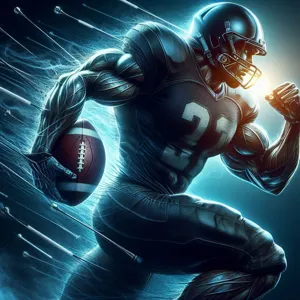
Visualization and mental rehearsal are powerful tools in the arsenal of any athlete, especially in the high-stakes world of American football. This technique isn’t just about picturing oneself making a great catch or scoring a touchdown; it’s about creating a vivid mental landscape where every play, every movement, and every decision is rehearsed in detail. When players engage in visualization, they harness the power of their imagination to simulate game scenarios, allowing them to approach real-life situations with enhanced confidence and clarity.
Imagine a quarterback standing on the sidelines before a game, eyes closed, guiding his mind through the perfect play. He visualizes the snap, the rush of defenders, the precise angles of his receivers’ routes, and the triumphant moment of the successful pass. This mental rehearsal not only helps reinforce muscle memory but also prepares the mind for the intense pressure and unpredictability of the game.
Research indicates that when athletes visualize their performance, they activate similar brain patterns as when they physically execute those movements. This neural wiring can lead to improved execution on the field, as players feel more familiar and prepared for various game situations. Additionally, visualization can help reduce anxiety by allowing players to experience success in their minds, alleviating the stress that often accompanies performance in front of thousands of fans.
To implement visualization effectively, players should carve out time each day to practice this technique, ideally in a quiet space where they can focus. They can start by closing their eyes and taking deep breaths to clear their minds, then envisioning not just the plays but also their emotional state during those pivotal moments—feeling the adrenaline, the excitement, and the satisfaction of executing flawlessly. Over time, this practice can become a crucial part of their mental training regimen, transforming how they approach the game and bolstering their overall resilience.
Incorporating visualization and mental rehearsal into your training routine can truly be a game-changer, shaping not just skilled athletes but mentally tough competitors ready to face any challenge on the field.
8. Embracing Challenges: Learning from Adversity
Embracing challenges is an essential component of developing mental toughness in American football. The gridiron is not just a physical battlefield; it is a crucible for character. Every player faces moments of adversity, whether it’s a tough loss, an injury, or the pressure of a high-stakes game. These challenges can either break a player or mold them into a stronger competitor. The key lies in how they respond to these adversities.
When a player encounters a setback, it presents a unique opportunity for growth. Instead of shying away from difficulties, those who embrace them are likely to come out on the other side more resilient. Coaches can foster this mindset by creating an environment where challenges are viewed as learning experiences rather than insurmountable obstacles. Encourage players to reflect on past adversities and the lessons learned, whether it was improving their skills, enhancing their strategies, or developing stronger teamwork.
Moreover, integrating drills and scenarios that mimic high-pressure situations can help players mentally prepare for real game challenges. This might include practicing in adverse weather conditions or simulating a last-minute game scenario where the outcome relies on their performance. The more familiar players become with adversity, the better equipped they will be to handle it when it arises in actual games.
Building a culture that celebrates resilience is also crucial. Share stories of legendary players who have faced and overcome significant challenges. Highlighting these narratives can inspire current athletes to adopt a similar mindset. Remember, mental toughness isn’t built overnight; it’s a continuous journey of learning, adapting, and growing stronger through every challenge faced on and off the field. By embracing adversity, players not only enhance their own resilience but also contribute to a team culture that thrives on overcoming obstacles together.
9. The Power of Positive Self-Talk
### 9. The Power of Positive Self-Talk
In the high-stakes world of American football, where physical prowess meets mental acuity, the dialogue within an athlete’s mind can often be the difference between victory and defeat. Positive self-talk is a powerful tool that athletes can harness to cultivate mental toughness and resilience. This internal narrative shapes their confidence, influences their emotions, and ultimately determines their performance on the field.
Imagine a player who has just missed a crucial tackle or fumbled the ball during a critical game moment. The immediate instinct might be to spiral into self-doubt, replaying the mistake over and over in their mind. However, players who actively engage in positive self-talk can transform this narrative. Instead of berating themselves with phrases like “I’m a failure” or “I let my team down,” they can shift their focus to constructive affirmations such as “I learn from my mistakes” or “I will bounce back stronger.” This shift not only mitigates the impact of negative emotions but also reinforces a growth mindset.
Incorporating positive self-talk into training routines can be as simple as developing personalized affirmations that resonate with each player’s unique journey and goals. Coaches can encourage players to repeat these affirmations before drills or games, fostering a sense of empowerment and readiness. Techniques such as visualization can also enhance the effectiveness of self-talk; athletes can picture themselves succeeding while simultaneously reciting their affirmations, creating a powerful mental image that reinforces their belief in their abilities.
Moreover, the influence of positive self-talk extends beyond individual performance. When players adopt an encouraging mindset, they inadvertently uplift their teammates, fostering a culture of support and resilience within the entire team. This camaraderie can be invaluable during challenging moments in a game, as players are more likely to rally around one another and maintain their focus.
In a sport where the pressure mounts and the stakes are high, mastering the art of positive self-talk can serve as a cornerstone for building resilience. By embracing this one simple yet profound technique, players not only enhance their performance but also develop the mental fortitude necessary to navigate the ups and downs of football—and life.
10. Building a Supportive Team Culture
A supportive team culture is the backbone of mental toughness in American football. In a sport where physical prowess often gets the spotlight, it’s easy to overlook the profound impact that a positive environment can have on players’ resilience and performance. Creating a culture that values encouragement, collaboration, and open communication fosters not only individual growth but also strengthens the collective spirit of the team.
To build this supportive culture, coaches and team leaders must prioritize relationships among players. Regular team-building activities—whether on or off the field—can help players bond and develop trust in one another. It’s essential for athletes to feel that their teammates have their backs, especially during challenging moments on the field. Encouraging players to share their experiences, both successes and struggles, promotes a sense of belonging and reinforces the idea that they are not alone in facing adversity.
Furthermore, incorporating mentorship opportunities can significantly enhance this supportive atmosphere. Pairing seasoned players with newcomers allows for the transfer of knowledge and experiences, creating a nurturing environment where all players feel valued. Mentorship not only builds confidence but also instills the importance of resilience in overcoming obstacles—an essential lesson for any athlete.
Coaches must also lead by example, modeling positive behavior and fostering an inclusive environment where feedback is constructive and growth-oriented. Recognizing and celebrating individual and team achievements, no matter how small, can uplift morale and motivate players to push through tough times. When athletes know their efforts are appreciated, they are more likely to remain committed and resilient, both in practice and during games.
In summary, a supportive team culture is foundational to training mental toughness in American football. By emphasizing relationships, mentorship, and positive reinforcement, coaches and players can cultivate an environment where resilience thrives, ultimately enhancing overall performance on the field and creating a lasting camaraderie off of it.
11. Incorporating Resilience Training into Practice Sessions
Incorporating resilience training into practice sessions is essential for developing mental toughness among football players. This isn’t just about pushing athletes to their physical limits; it’s about creating an environment where they learn to face adversity, adapt, and thrive under pressure. A well-structured practice that integrates resilience training can transform how players approach challenges both on and off the field.
Begin by designing drills that simulate high-pressure situations. For instance, set up scenarios where the team is down by a certain number of points with only a few minutes left on the clock. This not only tests their physical abilities but also forces them to remain composed, strategize quickly, and work collaboratively to find solutions. Encourage players to vocalize their thoughts during these drills, fostering a culture of communication and problem-solving.
In addition to situational drills, consider incorporating mental conditioning exercises that focus on visualization and mindfulness. Before or after intense practice sessions, guide players through visualization techniques where they imagine themselves succeeding in challenging situations. This mental rehearsal can enhance their confidence and prepare them for real-game scenarios. Mindfulness exercises, such as breathing techniques or meditation, can also help athletes learn to manage stress and maintain focus amidst the chaos of competition.
Furthermore, create opportunities for players to reflect on their experiences. After each practice, hold brief discussions where athletes can share their feelings about overcoming challenges during the session. This reflection not only reinforces the lessons learned but also builds a sense of camaraderie and support within the team. Celebrate small victories, whether it’s a player overcoming hesitation or a team working together to complete a difficult drill. Recognizing these efforts fosters a growth mindset, encouraging athletes to embrace challenges as opportunities for improvement.
By systematically integrating resilience training into practice sessions, coaches can instill the mental toughness necessary for athletes to excel on the field. This holistic approach not only prepares players for the rigors of football but also equips them with the life skills needed to navigate challenges beyond the game. As athletes learn to embrace adversity, they become more resilient individuals, ready to face whatever challenges lie ahead.
12. Real-Life Success Stories: Players Who Exemplify Resilience
When it comes to mental toughness in American football, the stories of certain players resonate like a powerful play in the final moments of a game. These athletes not only showcase outstanding physical abilities but also embody resilience, overcoming personal and professional challenges to achieve greatness on the field.
Take, for example, the inspiring journey of Tom Brady. Drafted in the sixth round of the 2000 NFL Draft, he was often overlooked and doubted. Instead of succumbing to the negativity surrounding his selection, Brady channeled that doubt into determination. Through countless hours of practice and a relentless pursuit of perfection, he transformed himself into one of the most successful quarterbacks in NFL history. His ability to bounce back from setbacks, such as the infamous Super Bowl loss in 2007, showcases his unparalleled mental fortitude and commitment to excellence.
Another compelling example is the story of Adrian Peterson. After suffering a devastating knee injury in 2011 that sidelined him for much of the season, many speculated that his career might be over. However, Peterson returned with astonishing vigor the following year, rushing for over 2,000 yards and earning the NFL MVP award. His grit and perseverance not only inspired his teammates but also set a benchmark for athletes across all sports, proving that resilience can lead to extraordinary comebacks.
Then there’s the story of Michael Strahan, a legendary defensive end who faced personal challenges both on and off the field. Strahan’s journey from a struggling player to a Super Bowl champion is a testament to his resilience. He overcame adversity, including injuries and criticism, to become a key player for the New York Giants, ultimately leading them to victory in Super Bowl XLII. His transition from player to successful television personality further illustrates that resilience extends beyond the field, influencing all aspects of life.
These real-life success stories are not just anecdotes; they serve as powerful reminders of the strength of the human spirit. Each of these players faced moments of doubt, injury, or criticism, yet they harnessed their struggles, demonstrating that true mental toughness is about rising after a fall and continuing to strive for excellence. By learning from their journeys, aspiring athletes can cultivate their own resilience, setting the stage for success both on and off the field.
13. Evaluating Progress: Tools and Metrics for Mental Toughness
Evaluating progress in mental toughness is essential to ensuring that your training is effective and that players are developing the resilience needed to thrive under pressure. In the realm of American football, where the stakes are high and the competition is fierce, using the right tools and metrics can make all the difference in understanding how well athletes are cultivating their mental fortitude.
One of the most effective ways to measure mental toughness is through self-assessment questionnaires. These tools often include questions that prompt players to reflect on their responses to challenging situations, their ability to maintain focus during games, and their overall confidence levels. By regularly completing these assessments, athletes can track their growth over time and identify areas that require further attention.
Another valuable metric is performance analysis during practice and games. Coaches can observe how players handle pressure scenarios, such as critical game moments or intense practice drills. Keeping a record of players’ reactions—whether they thrive, struggle, or show signs of improvement—provides concrete data that can be discussed during one-on-one evaluations. Video analysis can also be instrumental; reviewing game footage allows athletes to see themselves in high-pressure situations and learn from their reactions.
Additionally, incorporating feedback from teammates and coaches can offer unique insights into an individual’s mental toughness. Peer assessments can highlight how players respond to adversity as part of a team, fostering a culture of accountability and mutual support.
Finally, consider utilizing biometric tools such as heart rate variability (HRV) monitors to assess stress responses during training. A player’s physiological responses can provide crucial information about their mental state and resilience. If their HRV shows high levels of stress during challenging drills, it may indicate a need for targeted mental toughness training.
By employing a combination of self-assessments, performance analyses, peer feedback, and biometric monitoring, coaches and players can create a comprehensive picture of mental toughness development. This ongoing evaluation process not only enhances personal growth but also strengthens the entire team’s resilience, ultimately leading to improved performance on the field.
14. The Coach’s Role in Fostering Mental Resilience
The coach’s role in fostering mental resilience in American football is both pivotal and multifaceted. A coach isn’t merely a strategist or a drill sergeant; they are also a mentor, a motivator, and, importantly, a psychological architect shaping the mental landscape of their players. In the high-pressure environment of football, where the stakes are high and the competition fierce, a coach must equip their athletes with the tools to build mental toughness that will last well beyond the gridiron.
To begin with, a coach sets the tone for the team’s culture. By emphasizing growth mindset principles, they encourage players to perceive challenges as opportunities for improvement rather than insurmountable obstacles. This proactive approach nurtures resilience, allowing players to bounce back from setbacks, whether it’s a tough loss or a personal performance issue. Consistent reinforcement of this mindset during practices, in team meetings, and through one-on-one interactions can instill a sense of confidence that players can rely on during critical moments in games.
Moreover, a coach’s communication style plays a crucial role in developing mental resilience. Constructive feedback, rather than just criticism, empowers players to learn from their mistakes without fear of failure. By creating an environment of trust and open dialogue, coaches can help athletes understand that failure is a natural part of the learning process, paving the way for greater perseverance in the face of adversity.
In addition, incorporating mental conditioning techniques into training sessions can further solidify a player’s resilience. This could involve mindfulness practices, visualization techniques, or even simulated high-pressure scenarios that replicate the intensity of a game situation. Coaches can work with sports psychologists to design mental drills that challenge athletes to push through discomfort and uncertainty, ultimately teaching them how to maintain focus and composure when it matters most.
Lastly, a coach must be a role model of resilience themselves. By demonstrating their own ability to handle pressure, setbacks, and the inevitable challenges that come with coaching, they inspire players to adopt similar attitudes. When athletes see their coach navigating difficulties with grace and determination, they are more likely to internalize those qualities and emulate them on the field.
In sum, the coach’s role in fostering mental resilience in American football cannot be overstated. By cultivating a positive team culture, employing effective communication strategies, integrating mental training, and leading by example, coaches can empower their players to not only excel in the game but also develop a lifelong resilience that will serve them well in all aspects of life.
15. Conclusion: Making Resilience a Core Value in Football
In the high-stakes world of American football, resilience is not just an asset; it’s a core value that can define the trajectory of a team and the careers of its players. As we conclude this guide, it’s essential to emphasize that mental toughness is as vital as physical prowess on the field. The ability to bounce back from setbacks, maintain focus under pressure, and cultivate a relentless spirit can make all the difference during critical game moments.
To truly embed resilience within the fabric of your team culture, it must be prioritized at every level—from coaching strategies to player development. Coaches play a pivotal role in modeling resilient behavior and fostering an environment where adversity is viewed not as a roadblock, but as an opportunity for growth. Incorporating resilience training into regular practice routines, facilitating open discussions about mental health, and encouraging players to share their personal experiences can create a supportive atmosphere that promotes psychological strength.
Moreover, resilience should be celebrated as a team value. Recognizing and rewarding players who exemplify mental toughness—whether by overcoming injuries, bouncing back from tough losses, or supporting teammates in distress—reinforces its importance. By doing so, you not only enhance individual character but also build a cohesive unit that thrives on mutual support and shared determination.
Ultimately, making resilience a core value in football involves a commitment to ongoing growth, both on and off the field. It’s about teaching players that setbacks are a part of the journey, and every challenge faced is a stepping stone towards greater achievements. As teams embrace this philosophy, they cultivate not just athletes, but champions—those who will thrive under pressure, inspire others, and leave a lasting impact on the game. Embrace the journey, foster resilience, and watch your team unlock its full potential.
In conclusion, developing mental toughness is just as crucial as honing physical skills in American football. By implementing the strategies outlined in this guide—from fostering a growth mindset and embracing adversity to practicing visualization and maintaining peak physical condition—you can unlock your resilience and elevate your game to new heights. Remember, mental toughness is not built overnight; it requires dedication, practice, and a willingness to push beyond your limits. As you embark on this journey, know that every challenge you face is an opportunity for growth. Embrace the process, and watch as your newfound resilience transforms not only your performance on the field but also your approach to life’s challenges off the field. Keep striving, stay focused, and let your mental toughness shine!

